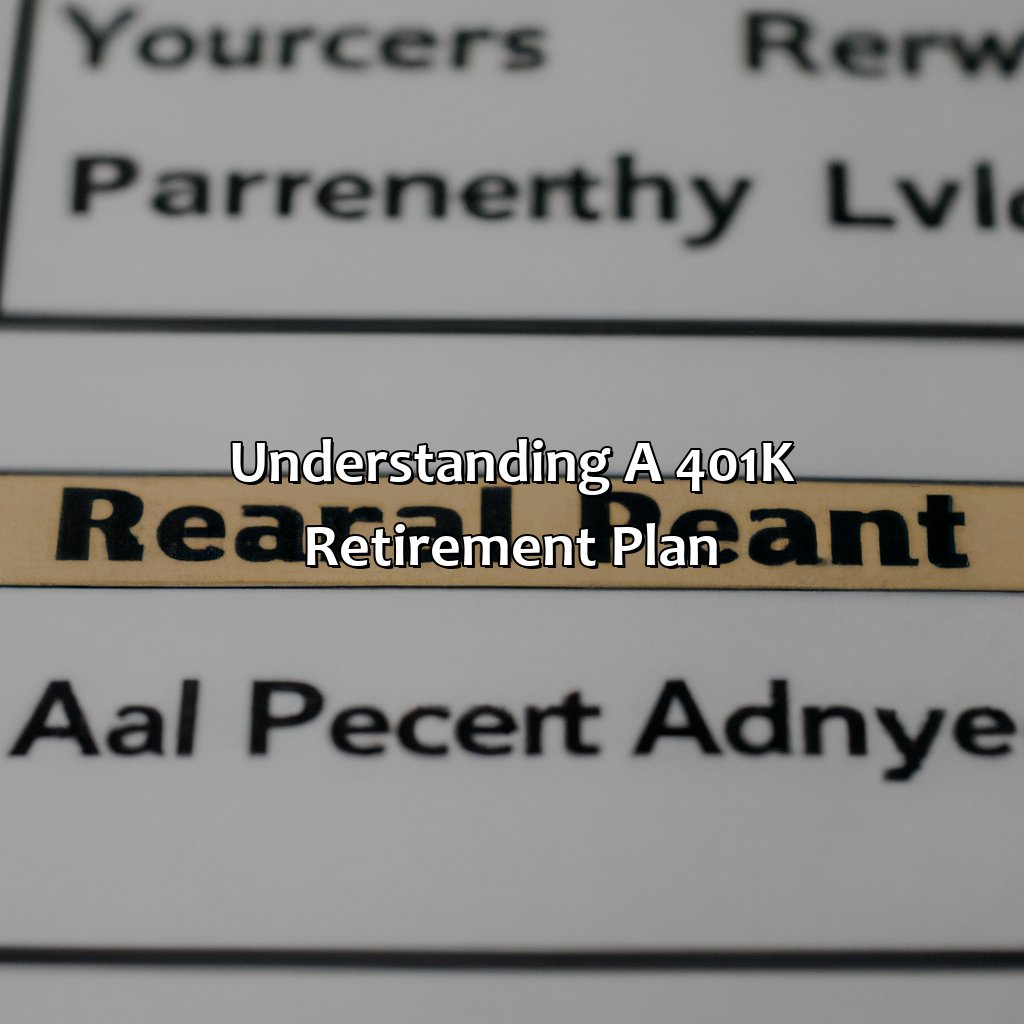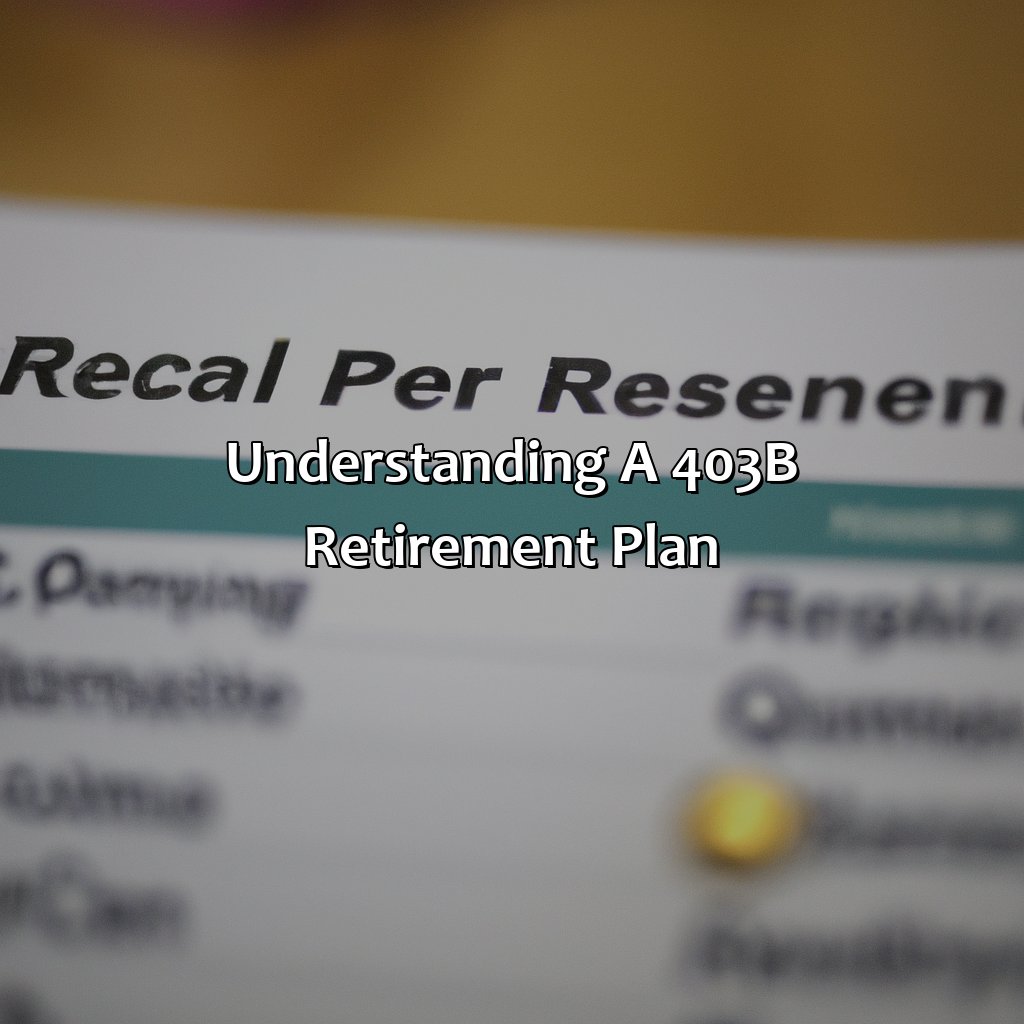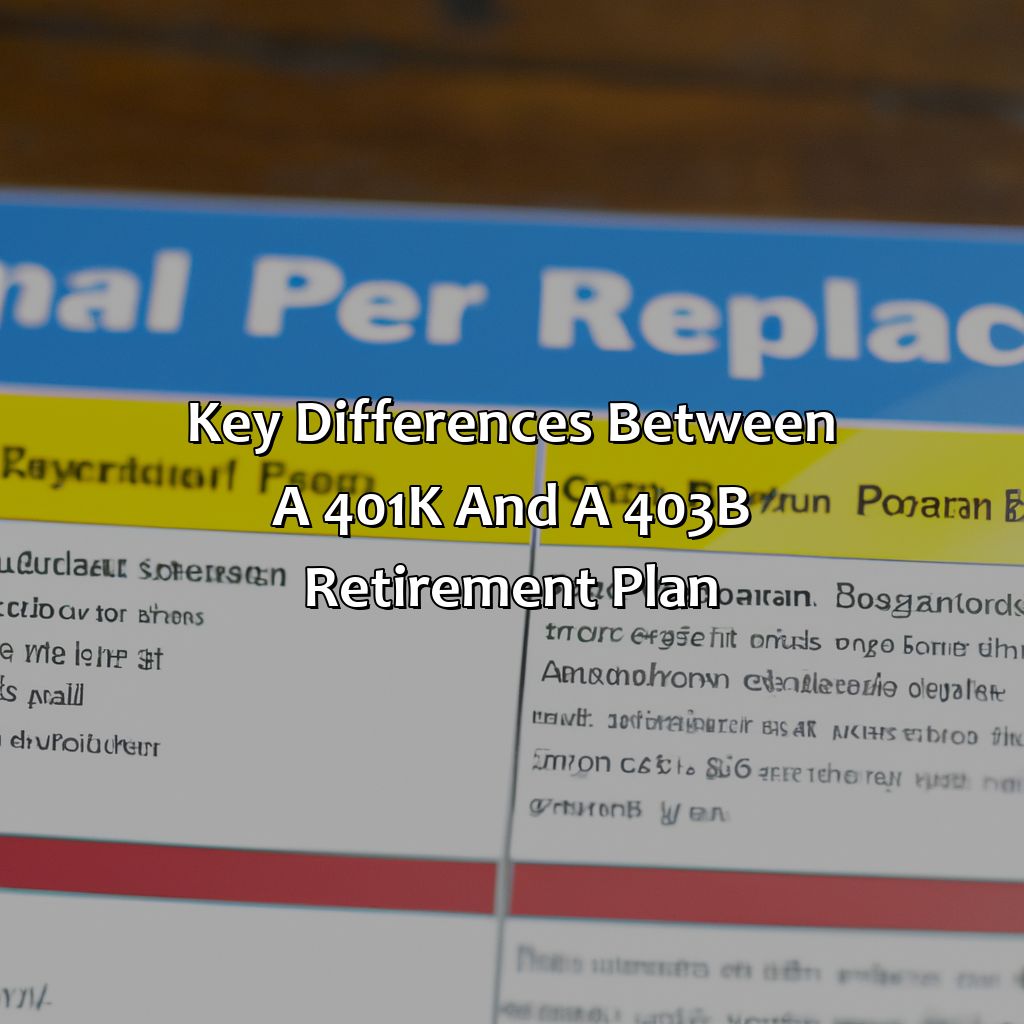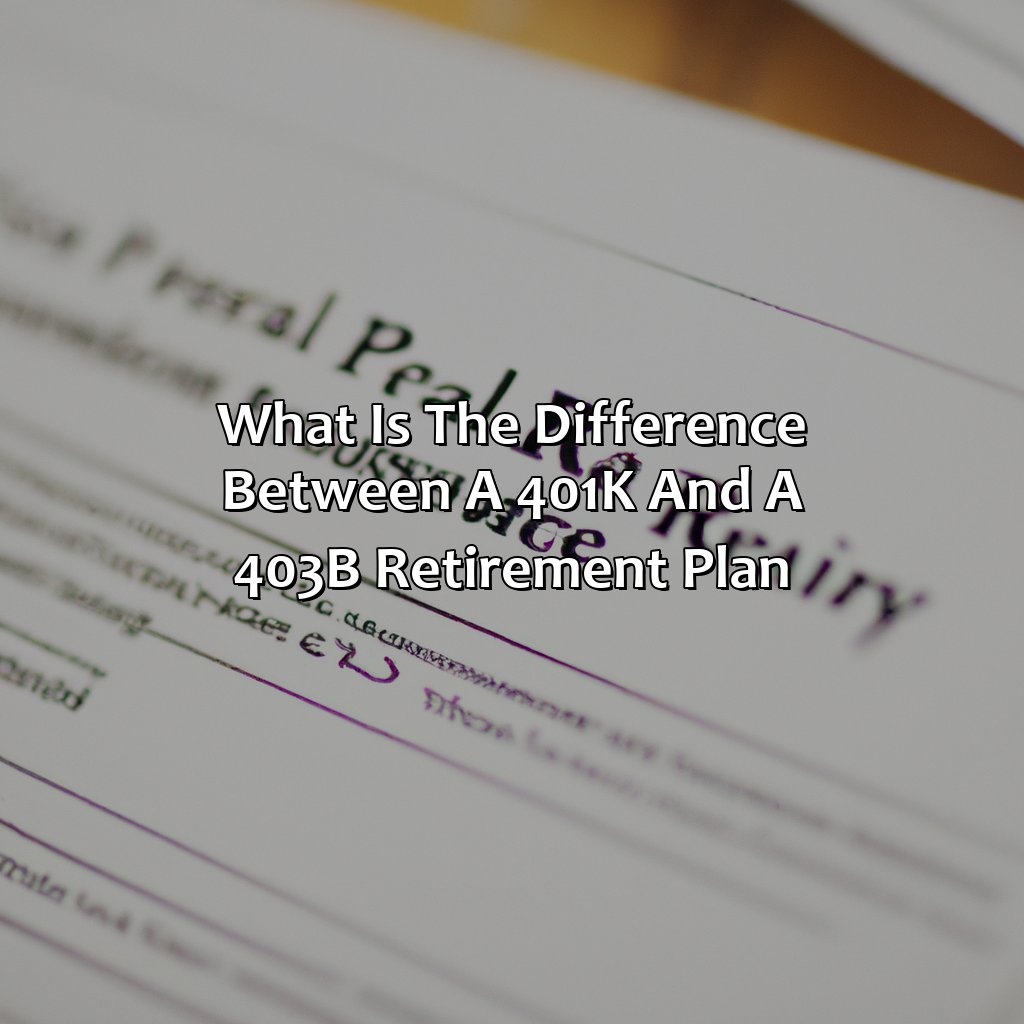What Is The Difference Between A 401K And A 403B Retirement Plan?
Key Takeaways:
- A 401k retirement plan is typically offered by for-profit companies, while a 403b plan is typically offered by non-profit organizations such as schools and hospitals.
- 401k plans may offer higher contribution limits and more diverse investment options, but 403b plans may have lower fees and offer more opportunity for additional catch-up contributions.
- It’s important to carefully consider your employer type, contribution limits, and investment options when choosing between a 401k and a 403b retirement plan that best fits your individual retirement needs.
Are you trying to decide which retirement account makes the most sense for you? You need to understand the difference between a 401k and a 403b retirement plan to make the best decision. In this article, you’ll get the know-how to compare these two options.
Understanding a 401k retirement plan
To grasp the ins and outs of a 401k retirement plan, think of it as your retirement savings solution. You can maximize contributions, get tax benefits, but also have withdrawal penalties. We’ll look at the key features, advantages and disadvantages to help you make a wise decision for your retirement.

Image credits: retiregenz.com by Adam Arnold
Key features of a 401k
A 401k retirement plan enables individuals to save funds for their retired life. It is an ideal way for employees to create a retirement fund as it offers several benefits:
- Employer Contribution: While contributing to the account, employers can also make a contribution to the employee’s 401k account.
- Tax Benefits: Employees can receive tax benefits on their contributions as it reduces the taxable income amount.
- Investment Options: Funds invested in a 401k account may offer a variety of investment options provided by mutual funds and other investment instruments like stocks and bonds.
- Withdrawals: Individuals can withdraw from their account when they retire or leave their current employer, possibly at age 59.5 years, without attracting significant penalties.
A 401k retirement scheme permits individuals to save money while they are still earning toward their golden years. Though there are similar plans, such as a 403b plan that is used by public agencies and non-profit organizations, which are appropriate for certain types of employees with specific job roles.
When thinking about your future, setting up a 401k ensures steady finances in your later years of life. By enrolling in your company’s plan now and saving what you can, you won’t have to worry about missing out on the opportunity later down the road. Start planning today!
Forget about the advantages, let’s talk about the real disadvantage of a 401k: realizing you’ll have to work until you’re 87 to retire comfortably.
Advantages and disadvantages of a 401k
A Comprehensive Review of the Pros and Cons of Enrolling in a 401k Retirement Plan
A 401k retirement plan provides people an opportunity to invest their money into long-term savings.
- One advantage of a 401k is that it allows employees to deduct contributions from their taxable income.
- Another benefit is that employers often match employee contributions, making it possible for individuals to maximize their savings.
- A disadvantage of a 401k, however, is that investments are subject to market fluctuations and can be risky ventures.
Furthermore, certain retirement accounts have similar features to a 401k, such as a Roth IRA or a traditional IRA. These plans do not receive employer matches but can provide tax benefits or mitigations.
For example, my colleague was advised against signing up for the 401k because they faced mounting credit card debt. Instead, they began investing in opening up an IRA account until their finances stabilized.
Saving for retirement is like playing a game of Monopoly, just make sure you’re choosing the right board – now let’s talk about the 403b.
Understanding a 403b retirement plan
Understand a 403b retirement plan by exploring its key features. This plan could be the solution for you. Find out the pros and cons of a 403b. It’s important to know the key features before you pick this plan over a 401k. Knowing the advantages and disadvantages of a 403b will help you make a smart decision about your retirement.

Image credits: retiregenz.com by Yuval Arnold
Key features of a 403b
A 403b is a retirement plan designed for non-profit organizations and public schools employees. Key features of this plan include tax-deferred contributions, automated investment options, contribution matching, and different withdrawal options. Tax-deferred contributions allow individuals to save on taxes since their contributions are deducted from their taxable income. Automated investment options provide ease in portfolio management, while a Contribution Matching system ensures a higher retirement pool, as the employer matches some percentage of employee contributions. There are different withdrawal options available; these vary depending on the type of institution and state regulations.
It is essential to know that there is no one-size-fits-all solution when it comes to 403b plans. Each organization has its rules and regulations regarding contributions, matching percentages, and withdrawal options.
In the past years, there have been significant changes in regulating 403b plans due to mismanagement of funds by some organizations. Organizations can now choose whether they want ERISA protection for their employees or not. ERISA protection safeguards against fraudulent activities by providing fiduciary liability protection to the organization’s decision-makers.
In summary, understanding the key features of a 403b is crucial for individuals employed in non-profit organizations or public schools. It is essential to take note of organizational specifications around contribution limits and matching percentages when planning for retirement. Finally, staying informed about current regulations surrounding retirement plans will ensure that future financial security is not jeopardized by mismanagement or fraudulent activities within the organization.
Advantages and disadvantages of a 403b:
Your retirement plan options: 403b– the perfect mix of saving for the future and accidentally supporting your niece’s girl scout troop.
Advantages and disadvantages of a 403b
A 403b retirement plan has been gaining popularity over the years, with many employers adopting it. This plan is designed for employees of public schools, non-profit organizations, and some private sector organizations. This NLP Variation focuses on the Pros and Cons of a 403b.
- Advantages:
- Employees can contribute to this plan through automatic payroll deductions.
- The money contributed is tax-deferred until you withdraw it in retirement, reducing your current taxable income.
- Employers can match contributions up to a certain percentage, providing additional savings.
- The investment options are varied and offer several choices based on risk tolerance and goals.
- Disadvantages:
- The contribution limit is lower compared to other retirement plans like 401k. This could impact the retirement corpus negatively for high earners.
- The fees associated with the funds can be higher than other options.
- They are subject to stricter rules about when withdrawals can be taken without penalties.
- The investment options may not be as broad as those offered by other retirement plans.
It’s worth noting that while a 403b has its advantages, its significance depends on individual needs and unique financial situations. Therefore making well-informed decisions when opting for these investments is crucial.
An interesting piece of history surrounding the introduction of 403b was back in the early ’50s where teachers’ needs for supplemental retirement savings were acknowledged more widely. By 1958, almost half of public school teachers participated in voluntary salary reduction agreements aimed at investing in regulated annuities known today as 403bs. The law had undergone changes over time, allowing for greater contribution limits, diversification opportunities, rollovers option into similar vehicles upon job changes or even retirements.
Why settle for a 401k when you can upgrade to a 403b and add a little excitement to your retirement planning?
Key differences between a 401k and a 403b retirement plan
To distinguish between a 401k and 403b plan, you must consider essential sections such as employer types and eligibility, as well as contribution limits and employee matching. These areas are significant when deciding which plan is best for your retirement. Let’s inspect them more closely.

Image credits: retiregenz.com by Yuval Duncun
Employer types and eligibility
Employer Participation and Eligibility:
To participate in a 401k or 403b retirement plan, there are specific eligibility criteria determined by the employer.
- Employer Types- A major difference between the two plans is that a 401k plan is offered to private sector employees, while a 403b plan is exclusively for non-profit organization employees.
- Employee Eligibility- In a 401k plan, an employee can enroll as early as they begin working, regardless of job status. In contrast, 403b plans only allow employees with certain job classifications, such as full-time or faculty members, to participate.
- Contribution Limits- The contribution limits for both plans vary significantly depending on the employer’s policies.
- Matching Contributions- A significant difference between both plans is that employers who implement 403bs commonly provide matching contributions on a mandatory basis.
It is also important to note that some employers provide their employees with both types of retirement plans, allowing eligible employees to choose which one best suits their financial situation.
One point worth mentioning about employer eligibility would be that some non-profits use both retirement benefits packages at once but might still have differences in terms of company markets within the same industry.
It’s common for new graduates to misunderstand a few things about saving money due to student loan debt and starting expenses but restricting your savings can lead you down an unfulfilling road. This could eventually result in unsteady financial stability during post-retirement days.
Contributing to a retirement plan is like putting money in a piggy bank, except the bank is virtual and the piggy is imaginary.
Contribution limits and employee matching
For the retirement plans’ contribution limits and employee matching comparison, there are some differences between a 401k and a 403b plan. Here’s what you need to know.
| Employee Contribution Limits | Employer Matching | |
|---|---|---|
| 401(k) Plan | $19,500 (2021); $26,000 if age 50 or older | Up to 100% of the first 3% of employee contributions + up to 50% of the next 2% of employee contributions |
| 403(b) Plan | $19,500 (2021); $26,000 if age 50 or older | It varies depending on employer agreements; sometimes as much as dollar-for-dollar match up to a specified percentage point. |
In addition to these key differences between a 401k and a 403b regarding contribution limits and employee matching, there are other things you should be aware of. These include eligibility criteria, investment options, and investment fees. Therefore it is vital to research more before choosing which plan is best for you.
Make sure you understand the benefits of each retirement option before committing. Don’t miss out on your ideal future because you didn’t take the time to find out what would work best for you.
Choosing the right plan for your retirement needs
Retirement planning can be daunting, but with the right plan, you can secure a comfortable future. Here are some tips for choosing the best retirement plan. First, consider your employment status and the organization you work for. This will help you determine whether a 401(k) or a 403(b) plan is more suitable.
A 401(k) plan is ideal for private-sector employees, and it allows them to save for retirement while also reducing their taxable income. A 403(b) plan is meant for employees of nonprofits and government organizations. Although the two plans have similar features, they have some differences in contribution limits and investment options. Therefore, it’s important to evaluate the options that align with your short/long term goals when choosing the plan that suits your needs.
It’s also worth considering the employer matching contribution and vesting rules for each plan, which could impact your retirement savings. Additionally, review the tax implications for each plan, such as the tax treatment of contributions, withdrawals, and required minimum distributions.
Pro Tip: Regardless of the plan, contribute as much as you can with the limits set. Time is your friend when it comes to compounding interest and investment growth in preparation for retirement.

Image credits: retiregenz.com by Harry Washington
Five Facts About the Difference Between a 401k and a 403b Retirement Plan:
Both a 401k and a 403b retirement plan are tax-advantaged savings plans offered by employers to their employees. (Source: The Balance)
The primary difference between a 401k and a 403b retirement plan is the types of employers that offer them. (Source: NerdWallet)
401k plans are offered by for-profit companies, while 403b plans are offered by non-profit organizations, schools, and religious organizations. (Source: Investopedia)
401k plans have potential higher contribution limits and offer more investment options than 403b plans. (Source: The Balance)
Both 401k and 403b plans have early withdrawal penalties and required minimum distributions after age 70 and a half. (Source: NerdWallet)
FAQs about What Is The Difference Between A 401K And A 403B Retirement Plan?
What is the difference between a 401k and a 403b retirement plan?
A 401k and a 403b are both retirement savings plans offered to employees, but there are a few key differences between the two:
- Eligibility: Generally, 401k plans are available to employees of for-profit companies while 403b plans are available to employees of non-profit organizations, such as schools, hospitals, and religious organizations.
- Contributions: The maximum contribution limits for a 401k and a 403b differ slightly, with 401k plans allowing for higher contributions than 403b plans.
- Investment options: The investment options offered within a 401k plan may differ from those offered in a 403b plan, and can vary widely depending on the employer.
- Withdrawals: The rules and regulations around withdrawals from a 401k and 403b plan may differ, with 403b plans often requiring an additional level of approval before a withdrawal can be made.
Can you have both a 401k and a 403b?
Yes, it’s possible for an individual to have both a 401k and a 403b plan at the same time, but the total contributions made to both plans cannot exceed the annual contribution limit set by the IRS.
Which plan is better: a 401k or a 403b?
There is no one-size-fits-all answer to this question, as the “better” plan depends on a number of factors, such as your employer’s offerings and your personal financial goals. It’s important to carefully evaluate the investment options, fees, and other restrictions associated with each plan before making a decision.
Can you roll over a 401k into a 403b?
Generally, it is not possible to roll over a 401k into a 403b plan. However, it may be possible to transfer the funds from a 401k into an individual retirement account (IRA), which could then be transferred into a 403b plan.
Do 401k and 403b plans have the same contribution limits?
No, the contribution limits for a 401k and a 403b plan are different. For 2021, the maximum contribution limit for a 401k plan is $19,500, while the maximum limit for a 403b plan is $19,500.
Can you make catch-up contributions to a 403b plan?
Yes, individuals aged 50 or older may make catch-up contributions to their 403b plan in addition to their regular contributions. The catch-up contribution limit for 2021 is $6,500.
 Checkout this IRS Loophole
Checkout this IRS Loophole 





